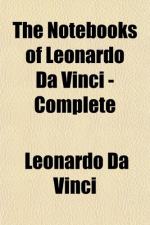611.
People were to be seen eagerly embarking victuals on various kinds of hastily made barks. But little of the waves were visible in those places where the dark clouds and rain were reflected.
But where the flashes caused by the bolts of heaven were reflected, there were seen as many bright spots, caused by the image of the flashes, as there were waves to reflect them to the eye of the spectator.
The number of the images produced by the flash of lightning on the waves of the water were multiplied in proportion to the distance of the spectator’s eye.
So also the number of the images was diminished in proportion as they were nearer the eye which saw them [Footnote 22. 23: Com’e provato. See Vol. II, Nos. 874-878 and 892-901], as it has been proved in the definition of the luminosity of the moon, and of our marine horizon when the sun’s rays are reflected in it and the eye which receives the reflection is remote from the sea.
VI.
THE ARTIST’S MATERIALS.
Of chalk and paper (612—617).
612.
To make points [crayons] for colouring dry. Temper with a little wax and do not dry it; which wax you must dissolve with water: so that when the white lead is thus tempered, the water being distilled, may go off in vapour and the wax may remain; you will thus make good crayons; but you must know that the colours must be ground with a hot stone.
613.
Chalk dissolves in wine and in vinegar or in aqua fortis and can be recombined with gum.
614.
PAPER FOR DRAWING UPON IN BLACK BY THE AID OF YOUR SPITTLE.
Take powdered gall nuts and vitriol, powder them and spread them on paper like a varnish, then write on it with a pen wetted with spittle and it will turn as black as ink.
615.
If you want to make foreshortened letters stretch the paper in a drawing frame and then draw your letters and cut them out, and make the sunbeams pass through the holes on to another stretched paper, and then fill up the angles that are wanting.
616.
This paper should be painted over with candle soot tempered with thin glue, then smear the leaf thinly with white lead in oil as is done to the letters in printing, and then print in the ordinary way. Thus the leaf will appear shaded in the hollows and lighted on the parts in relief; which however comes out here just the contrary.
[Footnote: This text, which accompanies a facsimile impression of a leaf of sage, has already been published in the Saggio delle Opere di L. da Vinci, Milano 1872, p. 11. G. GOVI observes on this passage: “Forse aveva egli pensato ancora a farsi un erbario, od almeno a riprodurre facilmente su carta le forme e i particolari delle foglie di diverse piante; poiche (modificando un metodo che probabilmente gli eia stato insegnato da altri, e che piu tardi si legge ripetuto in molti ricettarii e libri di segreti), accanto a una foglia di Salvia impressa in nero su carta bianca, lascio scritto: Questa carta ...




